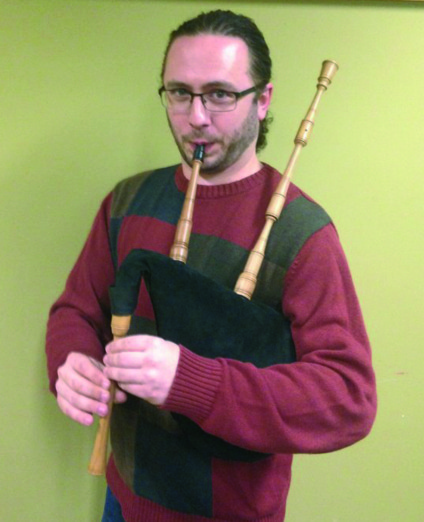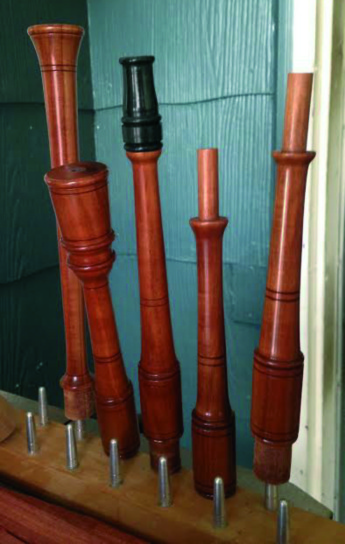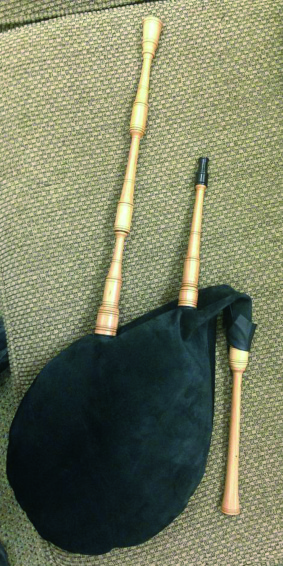The Bagpipe Society
The Benefits of Authenticity

Most makers of Renaissance instruments attempt to ‘copy’ those from the period. With no surviving bagpipes, this means relying on iconography and contemporaneous descriptions – and we have no shortage of pictorial evidence and a few detailed accounts of bagpipe design, including drone tuning. This pursuit of ‘authenticity’ has turned out some delightful and very useful instruments, owing much to the creativity of modern makers in filling in the missing information.
My goals in developing Renaissance smallpipes were a bit different. I wanted my pipes to be a perfect all around instrument for early music enthusiasts, amateurs, and professionals. While I did (loosely) base the outer turnings on late 15th and early 16th century Flemish paintings, I made no effort to copy a particular instrument. As for tuning, I did not start with a surviving description and fill in the gaps; rather I built an instrument for a specific purpose and need in the early music community – a well rounded but approachable early bagpipe. My objective was to make an instrument suitable for professional early musicians, but also remove obstacles (and fear) some instrumentalists may have when contemplating learning bagpipes.

The first admittedly inauthentic attempt in my quest was to use plastic reeds. Few can argue with the benefits of plastic reeds – they offer a stability and hassle-free playability that cane reeds simply cannot. Given a portion of my target clientele, some of whom cannot or do not wish to work on reeds, plastic was the ‘natural’ choice. Stability is not a small concern for beginning players and amateurs – often instruments sit for days or weeks between playing sessions. Instruments that require tinkering can easily discourage a player, but if the pipes play exactly as they did the last time, there is a much greater chance of personal improvement with each playing. My pipes also work with handmade cane reeds, however.
While many other pipes work with plastic reeds, most require either reeds made specifically for the instrument or heavily altered mass-produced reeds. Thus the next, not insignificant development was to design both the chanter and drone(s) to take stock practice chanter reeds. I chose two readily available brands, both on the hard/stiff end of the spectrum. Gibson and Abbott reeds were perfect options given their remarkable consistency and very similar brass tube sizes. They both play at the same pitch in my pipes making them interchangeable. With simple instructions on how to strip the thread from the brass tube, even non-reed players can easily replace reeds if necessary.
For a fingering system I chose Renaissance recorder fingering, or a fully open system. I, of course am not ignoring the benefits of semi-closed or fully closed systems on small cylindrical chanters, but I am favoring the accessibility of recorder-like fingerings. Many in the early music community who develop an interest in bagpipes have some level of experience on recorder. The simplest (well, most basic) fingering system offers the shortest learning curve.
My chanters produce C4 when all 8 holes are closed. They have a fully chromatic 9th in range excluding either the low Eb or C# (more on this below). Both the small bore and the long plastic reed allow for extremely stable cross fingerings. The F/F# is solved without a right hand thumbhole. F is fingered (T1234-6) and F# is achieved by both (T1234) and (T123-56). Bb requires no additions to the simple (T1-3), and C#5 is (T) and (12). C5 is cross fingered like recorder (T2). The curious (T12345-7) fingering produces either Eb or C#, depending on hole 6’s placement and size. I usually elect for C#, requiring hole 6 to be slightly smaller.

For the drone, I again opt for a likely inauthentic but very useful solution. As a single drone, the three joints full length produces a D one octave below (T123456). This offers the player authentic melodies in modes 1, 5, 7, 9, and 11 – or dorian, lydian, mixolydian, aeolian, and ionian. Pulling out the top drone joint about 5/8” exposes a hole slightly larger than the drone’s bore. This raises the drone pitch a perfect 4th to produce G one octave below (T123). This allows the player to play melodies in the corresponding plagal modes. Often called 2nd and 5th drones, these were my first drones offered. I now make an additional middle joint for the drone about 1” – 1 1/8” longer than the D/G middle joint. This lowers both available pitches by a tone. The C drone is a lovely sound, but the F drone is really the useful addition here. Many plagal melodies extend to the 6th above the final, which is not available in G but is in F. Also, this 4th drone is described by Praetorius (hummelchen), and many pastoral melodies are in plagal F mode. While perhaps not authentic, four available drone notes make my bagpipes very useful and flexible.
I didn’t stop there with modern improvements. Like many pipe makers I line the blowpipe with brass and turn a tip out of resin to prevent rot. Despite modern materials and lack of a historical ‘model’ my pipes turned out to be useful, flexible, and accessible to all levels of players. My pipes are used in early music workshops and professional performances alike, and my workshop is happily busy. For more information on Renaissance Smallpipes (A440 or A465, single or double drone) email ccrecorder@gmail.com.
Charles Wines (shawm, dulcian, recorder, bagpipe) is the artistic director of Forgotten Clefs: A Renaissance Wind Band. In demand as a Renaissance music specialist, Mr. Wines performs with Piffaro: The Renaissance Band. Additionally, Charles has performed on several period woodwind instruments (historical recorders, flute, oboe, and bassoon) with Opera Nova: Ensemble for Seventeenth-Century Music, Kansas City Baroque Consortium, St. Michael’s Baroque Ensemble, and Te Deum Antiqua. Charles studied instrument building with Joel Robinson in Portland, Oregon. He maintains a business selling double reeds for historical instruments and Renaissance woodwind instruments.
- Data Processing Notice (GDPR)
@BagpipeSociety on X (formally known as Twitter)
TheBagpipeSociety on Instagram
 BagpipeSociety on Facebook
BagpipeSociety on Facebook
Something wrong or missing from this page? Let us know!
